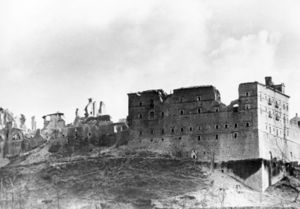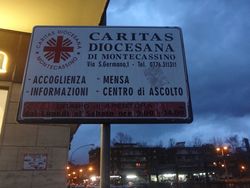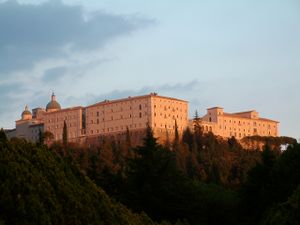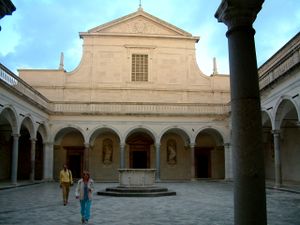مونتى كاسينو
مونتى كاسينو (Monte Cassino ، اليوم عادةً ما تُكتب Montecassino) هي ربوة صخرية على بعد 130 كم جنوب شرق روما، في الوادي اللاتيني، إيطاليا، على بعد 2 كم غرب بلدة كاسينو على ارتفاع 520 متر. موقع البلدة الرومانية كاسينم، المشهورة بديرها، أول مقر للرهبنة البندكتية، التي أسسه بندكت من نورسيا بنفسه حوالي سنة 529. ومن أجل مجتمع مونتى كاسينو تشكل حكم القديس بندكت.
. . . . . . . . . . . . . . . . . . . . . . . . . . . . . . . . . . . . . . . . . . . . . . . . . . . . . . . . . . . . . . . . . . . . . . . . . . . . . . . . . . . . . . . . . . . . . . . . . . . . . . . . . . . . . . . . . . . . . . . . . . . . . . . . . . . . . . . . . . . . . . . . . . . . . . . . . . . . . . . . . . . . . . . .
التاريخ
في عام 884 أغارت إمارة صقلية العربية على البلدة، وأحرقتها بالكامل،[1] وقـُتـِل رئيس الدير برتاريوس أثناء الهجوم. وبين المؤرخين العظام الذين عملوا في الدير، في تلك الفترة كان إرشمپرت، الذي كان كتابه Historia Langobardorum Beneventanorum تأريخاً أساسياً لـمدزوجورنو في القرن التاسع.
التاريخ الحديث
الموقع نهبته قوات ناپليون في 1799. ومنذ حل الأديرة الإيطالية في 1866، أصبحت مونتى كاسينو معلماً وطنياً.

أثناء معركة مونت كاسينو في الحملة الإيطالية في الحرب العالمية الثانية (يناير–مايو 1944) أصيب الدير بأضرار جسيمة. أنشأت القوات العسكرية الألمانية خط گوستاف بطول 161 كيلومتر، لمنع قوات الحلفاء من التقدم شمالًا. ومع ذلك، لم يتم استخدام الدير نفسه في البداية من قبل القوات الألمانية كجزء من تحصيناتهم، بسبب تقدير الجنرال كسلرنگ للنصب التاريخي. امتد خط گوستاف من التيراني إلى الساحل الأدرياتيكي في الشرق، مع إطلالة مونتي كاسينو نفسها على الطريق السريع 6 وسد الطريق إلى روما. وفي 15 فبراير 1944، تم تدمير الدير بالكامل تقريبًا في سلسلة من الغارات الجوية الثقيلة التي قادتها الولايات المتحدة. أمر بالقصف القائد العام لقوات الحلفاء في إيطاليا الجنرال السير هارولد ألكسندر من الجيش البريطاني. تم تنفيذ القصف لأن العديد من التقارير من القادة البريطانيين للقوات الهندية على الأرض تشير إلى أن الألمان كانوا يحتلون الدير، واعتبره مركز مراقبة رئيسي من قبل جميع الذين كانوا يقاتلون في الميدان.[2] ومع ذلك ، خلال القصف لم يكن هناك ألمان في الدير. ووجدت التحقيقات اللاحقة أن القتلى الوحيدين في الدير بسبب القصف هم 230 مدنيًا إيطاليًا يلتمسون اللجوء هناك.[3] عقب القصف تم احتلال أطلال الدير من قِبل فالشيرمييگر (المظليين) الألمان من الفرقة الأولى مظلات، لأن الأطلال شكلت غطاءاً دفاعياً ممتازاً.[4]

The Abbey was rebuilt after the war.[5] In the early 1950s, President of the Italian Republic Luigi Einaudi gave considerable support to the rebuilding.[6] Pope Paul VI consecrated the rebuilt Basilica on 24 October 1964. During reconstruction, the abbey library was housed at the Pontifical Abbey of St Jerome-in-the-City.[7] Until his resignation was accepted by Pope Francis on 12 June 2013, the Territorial Abbot of Monte Cassino was Pietro Vittorelli.[8] The Vatican daily bulletin of 23 October 2014 announced that with the appointment of his successor Donato Ogliari, the territory of the abbey outside the immediate monastery grounds had been transferred to the Diocese of Sora-Aquino-Pontecorvo, now renamed Diocese of Sora-Cassino-Aquino-Pontecorvo.[9]
الكنوز
In December 1943, some 1,400 irreplaceable manuscript codices, chiefly patristic and historical, in addition to a vast number of documents relating to the history of the abbey and the collections of the Keats-Shelley Memorial House in Rome, had been sent to the abbey archives for safekeeping. German officers Lt. Col. Julius Schlegel (a Roman Catholic) and Capt. Maximilian Becker (a Protestant), both from the Panzer-Division Hermann Göring, had them transferred to the Vatican at the beginning of the battle.[10]
Another account, however, from Kurowski ("The History of the Fallschirmpanzerkorps Hermann Göring: Soldiers of the Reichsmarschall"), notes that 120 trucks were loaded with monastic assets and art which had been stored there for safekeeping. Robert Edsel (2006) is more to the point about German looting. The trucks were loaded and left in October 1943, and only "strenuous" protests resulted in their delivery to the Vatican, minus the 15 cases which contained the property of the Capodimonte Museum in Naples. Edsel goes on to note that these cases had been delivered to Göring in December 1943, for "his birthday."[11]
المدفونون
- Pope Victor III
- Cardinal Domenico Bartolini (1813–87)
- Saint Apollinaris, abbot of Montecassino, feast day on 27 November
- Saint Benedict
- Saint Bertharius, abbot of Montecassino
- Józef Gawlina, archbishop and Divisional general
- Saint John Gradenigo
- Saint Scholastica
- Sigelgaita of Salerno
- Carloman (mayor of the palace)
- Władysław Anders
- Members of the Polish 2nd Army Corps
انظر أيضاً
- Battle of Monte Cassino
- Polish cemetery at Monte Cassino
- Red Poppies on Monte Cassino
- San Giovanni in Venere
- San Liberatore a Maiella
- The Cassino Band of Northumbria Army Cadet Force
- The Red Poppies on Monte Cassino
- Lamp of Brotherhood, lamps that were distributed at Monte Cassino to promote reconciliation after World War II
المراجع
- ^ Durant, Will (1950). The Age of Faith: A History of Medieval Civilization - Christian, Islamic, and Judaic - from Constantine to Dante: A.D. 325-1300. Simon and Schuster. p. 290.
- ^ "When I Landed the War Was over", by Hughes Rudd, American Heritage, October/November 1981.
- ^ Hapgood & Richardson, p. 211
- ^ Atkinson (2007), pp. 432-441
- ^ http://www.britishpathe.com/video/monks-rebuilding-monte-cassino
- ^ The Abbey of Monte Cassino: An Illustrated Guide undated English language publication
- ^ Bloch, Herbert (1986). Monte Cassino in the Middle Ages. Vol. 1. Cambridge, MA: Harvard University Press. p. xix. ISBN 0674586557.
- ^ "Pontifical Acts - 12 June". News.va. 12 June 2013. Retrieved 22 May 2016.
- ^ "Pontifical Acts - 23 October". News.va. 23 October 2014. Retrieved 22 May 2016.
- ^ Atkinson (2007), p. 399
- ^ Edsel, Robert M. (2006). Rescuing Da Vinci: Hitler and the Nazis Stole Europe's Great Art, America and Her Allies Recovered It. Laurel Pub. pp. 107. ISBN 9780977433490.
المصادر
- Atkinson, Rick (2007). The Day of Battle: the War in Sicily and Italy, 1943-1944. New York: Henry Holt. ISBN 978-0-8050-6289-2.
- Bloch, Herbert (1986). Monte Cassino in the Middle Ages. Vol. 1. Roma: Edizioni di Storia e Letteratura.
{{cite book}}: Invalid|ref=harv(help) - Christie, Neil (2006), From Constantine to Charlemagne: An Archaeology of Italy AD 300–800, Ashgate Publishing, ISBN 1-85928-421-3
- Catholic Encyclopedia, 1908.
- Hapgood, David; Richardson, David (2002) [1984]. Monte Cassino: The Story of the Most Controversial Battle of World War II (reprint ed.). Cambridge Mass.: Da Capo. ISBN 0-306-81121-9.
- Michela Cigola, L'abbazia benedettina di Montecassino. La storia attraverso le testimonianze grafiche di rilievo e di progetto. Cassino, Ciolfi Editore, 2005. ISBN 88-86810-28-8
وصلات خارجية
- Abbey of Monte Cassino
- Illustrated article on the Battle of Monte Cassino at Battlefields Europe
- MilitaryImages.Net
- Satellite photo from Google Maps
- The Monte Cassino Society
- Contemplationi faventes, original text of the 2014 apostolic constitution redefining territorial jurisdiction of the abbey
قالب:Landmarks of Lazio قالب:Roman Catholic Ecclesiastical Province of Rome Coordinates: 41°29′24″N 13°48′50″E / 41.49000°N 13.81389°E


